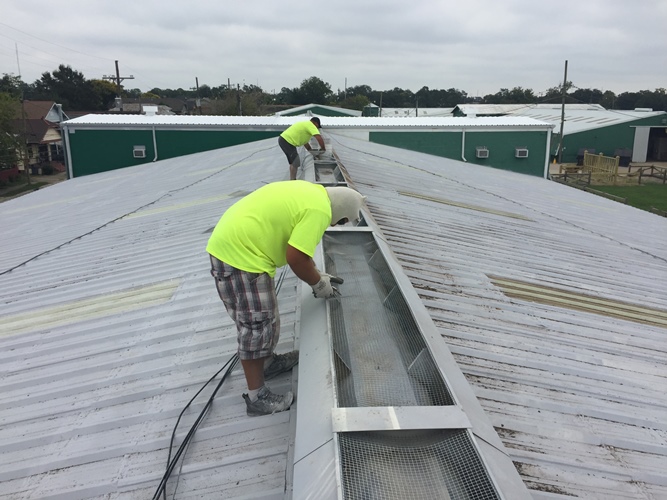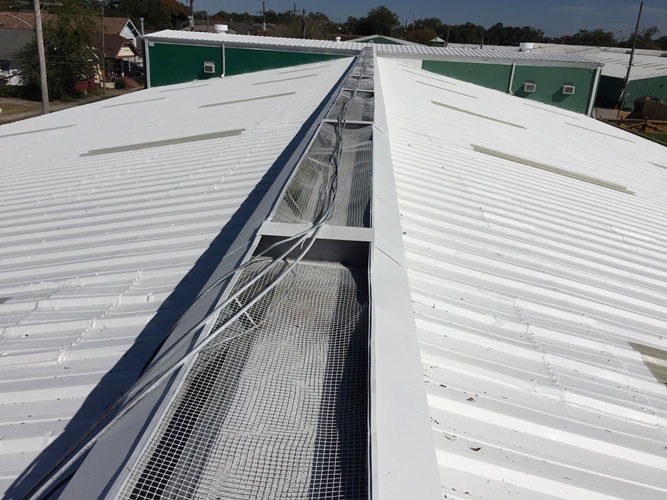Cool roofs aren’t necessarily new at this stage in the game, but offering a cool roof as a solution for a customer’s unique and specific problem? That may be a way to jockey into a position for a new project.
That’s exactly what happened at the New Orleans Fair Grounds Race Course. Not only was the old metal roof on one of the horse stables leaking, but the roof was also heating up the stable and the horses housed within.
According to Dave Laramouranne, CEO of GreenStar Roof Coatings, reducing the muscle fatigue and recovery of the thoroughbreds (worth tens of thousands of dollars) are huge challenges and highly sought after in the racing world. “These thoroughbreds have a cooler, more comfortable place to recover between races,” Laramouranne said. Any leg up on the competition would be a good move. “Even if there’s a slight difference, it’s an edge,” he explained. And so offering a cooler stable sounded like a great strategy to offer a competitive edge to this client.
Working as a “solutions partner” with general contractor Marsiglia Construction, GreenStar offered a solution with an advantage: A cool roof that would offer a drastic decline in temperature. Laramouranne and his five-person crew could take this metal roof down from 158° F (70.0° C) to 97° F (36.1° C) on a hot day, which would be cool for the client, their charges, and possibly a few purse strings.
Giddy Up!
First things first: Move the horses to another area for safe keeping. Knowing that there’d be six weeks using a horse hotel and new horses coming in soon after, the crew had very little wiggle room when it came to the schedule…and overspray.
“One of our challenges was wind. On windy days, we stopped operations because we were mitigating any overspray toward the horses so they wouldn’t breathe that in,” Laramouranne said.
On days that weren’t too windy, the crew pressure washed the roof with 3,500 psi (24.1 MPa) equipment from John Henry. “We got all the loose rust, mold, mildew, and debris — tree limbs and tree leaves,” Laramouranne said. Wearing steel-toed boots, 3M glasses, and nitrile gloves, they used two days to steam clean the roof.
Next on the card: prep. They started with a layer of ASTEC B-16-71 Rust Inhibitive Primer on the entire metal surface. Then, they gave the fasteners some much-needed attention. Loose ones were tightened, bad ones were replaced, and all of them were coated with a “dollop” of ASTEC Waterproofing Membrane (WPM) #9. The same material was used on all seams, although there, a reinforced Poly Cloth was embedded between two layers.
Finally, the crew upped their horsepower and moved onto the major coatings. They gave the roof surface a covering of ASTEC’s #2000 Finish. Working in a 150-foot-long (45.7 m) daisy chain from the blacktop to the rooftop, the crew applied two coats of this waterproofing membrane to a total average of 20 mils (508.0 microns) wet film thickness (WFT).

Working from one stop on the chain to another was an advantage. The sprayer up top was supported by a crew member holding the hose, and the rooftop duo was linked to another crew member in the trailer continuously mixing and filling the Graco 833 rig. “That’s another beauty: We don’t have to carry all of our materials up on the roof,” Laramouranne said. “It’s a lot safer, a lot more efficient, a lot faster.” It’s a rooftop triple crown.
Green Machine
The entire project took place in the middle of a New Orleans summer
— July and August to be exact. “And it was brutal,” Laramouranne said. “That’s when we had a heat wave coming through. It’s already hot here, and we had an abnormally hot August.” It was 110° F (43.3° C) outside! Clearly the cool roof, once complete, was a good choice for the horses and trainers that would later be back inside. But in the meantime, the GreenStar crew had to work with the heat. Their solution: cooling towels by Frogg Toggs.
Laramouranne was skeptical at first, but after using one — his was a green color, of course — he noticed a significant difference in how he felt. “These are some of the coolest, most innovative towels; it’s like an air conditioner,” he explained. The towels kept the crew cool and kept them safe from heat stroke and moving ahead. “You can go longer, because the important thing is keeping your head cool.”
The environmental implications of the crew’s practices enabled the crew to truly be able to stand by their green star claim on this project. The crew's environmental practices came mostly at the end of the project and included recycling their five-gallon (18.9 L) buckets and taking precautions not to waste any of the water-borne materials.
“Cleanup was to flush out the machine,” Laramouranne explained. “We pump it out ‘til the end.” Flushing water through the hose when the timing was right was a way for them to avoid wasting any material left in the line after the job was done. But it’s not a science. “It’s the art of spraying,” he continued. “You can feel it; you can feel when your hoses have a different material in them. You can really tell when the material changes. The hoses are about ¼-inch [0.64 cm] thick, so there’s not much room. You just know.”
Once the paint starts to run out, all that’s left in the line is water, which the crew sprays into a wash bucket. According to Laramouranne, this practice is “extremely efficient.”
Fast Track
Although Laramouranne said that, for the crew, “having horses walking around was a nice change of scenery,” having the thoroughbreds relocated was also a source of stress. For each day that the crew went over the schedule, the fairgrounds would be charged $100k for relocation fees. Talk about an incentive for winning!
No thanks to luck — this crew based their success on strategy — they ended their project on time. “Now, there’s not only the waterproofing, which is what 9 out of 10 people want, but it also cooled it down dramatically,” said Laramouranne. “I remember the metal roof being as hot as blacktop and that intense feeling of heat emanating through your feet,” he continued. “It’s now cool enough to walk on barefoot.”
The team took about three weeks to finish coating all 26,600 square feet (2,471.2 m²) of the now cool roof before cleaning out their hoses and racing home.
At the end of the day, a race is exactly what a lot of coatings projects come down to. They’re a race against the clock, against a budget, and against other non-coating systems. Laramouranne is curious as to how this system will compare with the stable next door that didn’t receive the new cool roof. But for now, he’s content that the client got a solution to the unique problem.
